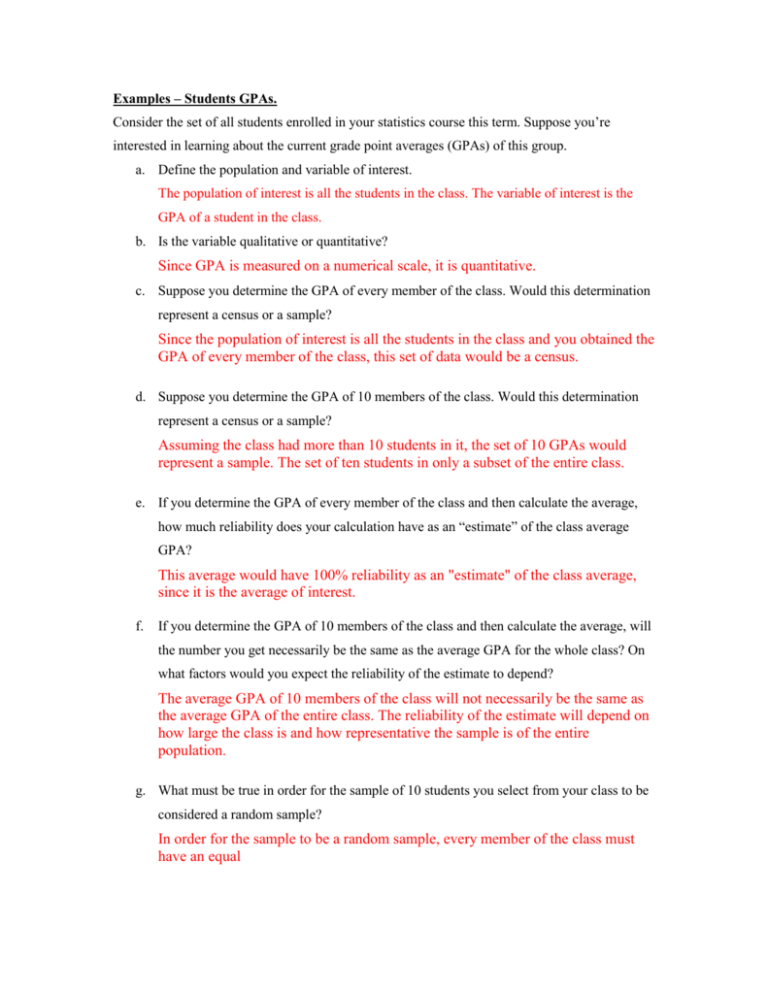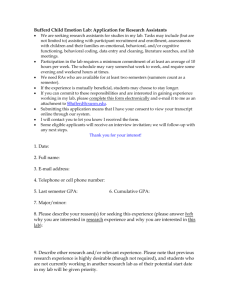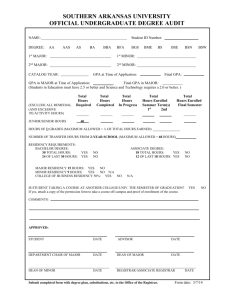MAT 1111
advertisement

Examples – Students GPAs. Consider the set of all students enrolled in your statistics course this term. Suppose you’re interested in learning about the current grade point averages (GPAs) of this group. a. Define the population and variable of interest. The population of interest is all the students in the class. The variable of interest is the GPA of a student in the class. b. Is the variable qualitative or quantitative? Since GPA is measured on a numerical scale, it is quantitative. c. Suppose you determine the GPA of every member of the class. Would this determination represent a census or a sample? Since the population of interest is all the students in the class and you obtained the GPA of every member of the class, this set of data would be a census. d. Suppose you determine the GPA of 10 members of the class. Would this determination represent a census or a sample? Assuming the class had more than 10 students in it, the set of 10 GPAs would represent a sample. The set of ten students in only a subset of the entire class. e. If you determine the GPA of every member of the class and then calculate the average, how much reliability does your calculation have as an “estimate” of the class average GPA? This average would have 100% reliability as an "estimate" of the class average, since it is the average of interest. f. If you determine the GPA of 10 members of the class and then calculate the average, will the number you get necessarily be the same as the average GPA for the whole class? On what factors would you expect the reliability of the estimate to depend? The average GPA of 10 members of the class will not necessarily be the same as the average GPA of the entire class. The reliability of the estimate will depend on how large the class is and how representative the sample is of the entire population. g. What must be true in order for the sample of 10 students you select from your class to be considered a random sample? In order for the sample to be a random sample, every member of the class must have an equal Examples – Insomnia and Education Is insomnia related to education status? Researchers at the Universities of Memphis Alabama at Birmingham, and Tennessee in investigated this question in the Journal of Abnormal Psychology (Feb. 2005). Adults living in Tennessee were selected to participate in the study, which used a random-digit telephone dialing procedure. Two of the many variables measured for each of the 575 study participants were number of years of education and insomnia status (normal sleeper or chronic insomniac). The researchers discovered that the fewer the years of education, the more likely the person was to have chronic insomnia. a. Identify the population and sample of interest to the researchers. The population of interest is the set of all adults living in Tennessee. The sample of interest is the set of 575 people selected from Tennessee. b. Identify the data collection method. Are there any potential biases in the method used? The data collection method used was a survey. A random-digit telephone dialing procedure was used to collect the sample. Since some people do not own phones, this would not be a random sample. Everyone in the state of Tennessee would not have an equal chance of being selected. Those without telephones would tend to be the undereducated. Thus, there could be potential biases in the data. c. Describe the variables measured in the study as quantitative or qualitative? The two variables identified in this problem are the number of years of education and the insomnia status of each subject. d. What inference did the researcher make? The researchers inferred that the fewer the years of education, the more likely the person was to have chronic insomnia. Examples – Poll on Alien Spacecraft “Have you ever seen anything that you believe was a spacecraft from another planet?” This was the question put to 1,500 American adults in a national poll conducted by ABC News and The Washington Post. The pollsters used random-digit telephone dialing to contact adult Americans until 1,500 responded. Ten percent (i.e., 150) of the respondents answered that they had, in fact, seen an alien spacecraft. (Chance, Summer 1997). No information was provided on how many adults were called and, for one reason or another, did not answer the question. a. Identify the data collection method. The data collection method used was a survey. b. Identify the target population. The target population is the set of all American adults. c. Comment on the validity of the survey results The sample was not a random sample. Thus, it may not be representative of all American adults. Many people contacted on the telephone refuse to participate in surveys.








